06.30.2014 | 2:01 pm
A Note from Fatty: My review of Phil Gaimon’s Pro Cycling on $10 a Day: From Fat Kid to Euro Pro is below. Be sure to read it, because it’s so insightful and enlightening that you will be unable to refrain from openly weeping.
And be sure to sign up for, mark your calendar for, and otherwise make sure you attend the live Q&A with Phil Gaimon on Tuesday, 12:00noon EDT / 11:00AM CDT / 10:00AM MDT / 9:00AM PDT. You can watch it below, but I really recommend you go to the Spreecast site to watch it, so you comment, ask questions, talk amongst yourselves, and whatnot. This is going to be a pretty fantastic opportunity to talk with one of the most down-to-earth pros you’ll ever meet; don’t miss it.
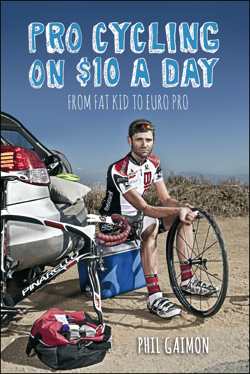 Review: Pro Cycling on $10 a Day, by Phil Gaimon
Review: Pro Cycling on $10 a Day, by Phil Gaimon
In general, I skip prefaces and introductions and forewords and dedications at the beginnings of books. And in general, I would recommend you do the same.
But for Phil Gaimon’s Pro Cycling on $10 a Day: From Fat Kid to Euro Pro, reading the preface is absolutely essential. It’s where Gaimon describes how some kids ask him for advice on how to rise through the ranks to become a pro cyclist.
Gaimon thinks about it, considering ways he could craft his response:
I’d sit them down for a lecture. I would start by explaining how hard it’s going to be, how many hears of solitude and poverty they’ll have to push through, and how many opportunities and relationships they’ll have to sacrifice. Only after the young riders grasped the downside would I feel comfortable explaining the beauty of the sport, what I’ve taken away from it, and why I wouldn’t trade it for anything.
And that is exactly what this book does. Using frequent aphoristic headings — as if they were guidance for the aspiring pro (“Get everything in writing,” “You can say no,” “Being right doesn’t always mean you win,” “Bacon is your friend”) — Gaimon tells his story, starting all the way back when he was a teenager, riding his way through college, and subsisting on way sub-minimum wage as a pro-in-sarcasm-quotes cyclist.
It’s a good story, and Gaimon tells it with a strong, personal (and personable) voice. He’s usually funny, frequently vulgar, sometimes naive, occasionally angry and accusatory, and once in a while he’s even serious and touching.
In other words, Gaimon comes across as a mostly-normal young man, who just happens to be an experienced writer (he’s written for both Bicycling and Velo magazines) with considerable ability, a lot of personal drive and ambition, and no small amount of personal discipline.
OK, so maybe he isn’t that normal.
My short-version assessment is that Pro Cycling on $10 A Day gives you an incredibly realistic and entertaining feel for what goes on in the minor leagues of pro cycling. It’s also the best—by far—of the current crop of cycling autobiographies.
It’s fun, it’s insightful, it’s surprising, and it’s well-worth reading.
So with that said, now let’s dig into what I like—and don’t like—about this book.
Detailed Storytelling
The single thing I liked the best about Gaimon’s writing is that he tells a great racing story—he talks about what he’s thinking and what he’s doing before the race, the moves and strategies during the race, and even what he wishes he would have done differently after the race. Early in the book, he gives an example of how he was bullied into doing more than his share of pulling:
I took a hard pull and flicked my elbow, asking Jonny for help.
“Fuck you! You pull us back there!” he replied. I kept pulling and didn’t say a word, but Jonny kept a consent barrage of insults coming, lashing me like a whip.”
And then,, after the stage:
I sat reluctantly beside Jonny Sundt, afraid to make eye contact after our interaction early in the race, but he was fine….It was a tactic, and it earned him a free ride across to the break.
A few things happen here. First, Gaimon pulls us not just into the action of the race, but into the personalities, strategies, and conversations of the race.
The second thing is Gaimon lets us take the verbal beating right alongside him. We don’t know why Sundt is attacking him until after the race is over…just as Gaimon didn’t.
Finally, we find ourselves wondering, after the fact, how we would have reacted to this kind of “barrage of insults.” Personally, I think I would have caved, and maybe not come back for more. And I started understanding—much more than I had before—that the toughness required of pro athletes is more than physical, more than mental. There’s an emotional toughness that’s required, and it’s a pretty critical component.
Gaimon doesn’t do the kind of navel gazing I just did, though. He just tells the race stories — both what’s happening around him and what’s going on in his head — with enough detail that, after a while, you get a much more clear picture of the inside of an elite-level race than you’ll ever get by watching on TV.
Fat Kid, But Not For Long
Pro Cycling on $10 A Day doesn’t have this kind of detail everywhere.
It seems strange to me that it has the subtitle, “From Fat Kid to Euro Pro,” and that the back cover text leads off with the “fat kid” angle, too (“Plump, lumpy, slumped on the couch and going nowhere fast at age 16…”). That kind of emphasis promises a central theme or plot point in the book.
As a guy who constantly fights to keep the weight off, I was interested.
The thing is, though, the book itself only barely mentions this “fat kid” phase. Indeed, a scant two pages is devoted to this transition, and is behind us before the middle of page 5.
In a book full of detail, it’s a pretty weak delivery of what the cover promises.
Mentors and Villains
Pro Racing on $10 A Day isn’t a thick book — just under 300 pages, plus the front matter and the glossary. However, thanks to the itinerant lifestyle and numerous races of a young, hyper-under-employed pro (Gaimon’s not kidding about the “$10 A Day” thing), Gaimon moves in and out of peoples’ lives with incredible frequency, to the point that my head was spinning with all the names, trying to remember from one page to the next who they were and whether I needed to remember them.
Which, come to think of it, is probably what Gaimon was doing, as well.
As the book progresses, however, there are certain people who emerge as standout characters—people who have strongly affected Gaimon’s life.
Jeremy Powers, more than anyone else, seems to be a mentor, as well as the person perhaps most responsible for helping Gaimon turn a corner in taking his career seriously, on investing in himself. Looking at the sparse food and almost non-heated status in Gaimon’s house, Powers tells Gaimon:
“How can you be fast when you have to wear a jacket in your own house?” he asked. “You can sit here and half-ass this thing, and you’l always make $20,000 a year, or you could do it right, invest in yourself, and make 10 times that. You know you have the talent, so stop being scared!
Over and over (63 mentions by name, according to my handy Kindle version of this book), Powers emerges as almost a North Star for Gaimon.
Gaimon’s admiration for / friendship with / loyalty to Powers comes through as a very touching thing. It also made me want to read Jeremy Powers’ autobiography; he comes across as a very centered, focused, and insightful person.
But where Gaimon has boundless admiration for Powers, he has nothing but scorn for Chad Thompson, who at the time was the “the boss” of the Kenda pro team, which Frankie Andreu directed and Gaimon rode for. Gaimon relentlessly ridicules Thompson and his apparently unbroken string of bad decisions, to the point where it starts feeling a little bit lopsided. I found myself wondering, “I wonder what the other side to this story is?”
And Shades of Grey
Gaimon starts his career — and the book — out brash, with a lot of youthful bluster. I don’t know how he manages it, but in a lot of cases he writes with more nuance and understanding as the book progresses; this mirrors his own growing experience. Early on, for example, he apologizes to the reader for not taking advantage of an opportunity to punch Lance Armstrong in the testicle.
Later, he relates how he trashes Tom Danielson for not knowing that he had made an agreement with Levi Leipheimer that he was going to go across to a breakaway. Still brash, but no longer straight-up juvenile.
Then, toward the end of the book, he’s training with the same Tom Danielson, and admiring his work ethic and dedication to training.
Eventually, he concludes, as he tries to resolve his disdain of doping with his friendship of those who have doped:
…You have to look at a person’s full body of work before you judge him. Frankie Andreu doped and I couldn’t have asked for a better friend or mentor. Jonathan Vaughters doped, and then brought cycling back from the edge of a cliff. Tom hadn’t made up for his doping yet, but I’d seen him pull over to help a stranger change a flat tire, and I could tell that he was just another normal guy who did something wrong.
It’s a well-put statement of someone who has strong convictions, which are beginning to be tempered by a complicated world.
Gaimon’s book ends essentially as he’s being brought into the big league. He’s still brash, he’s still himself. But he’s growing, and he’s interesting.
Phil Gaimon is a good writer, and it feels like he’s on the path to getting better. His story is compelling, honest, and funny.
I strongly recommend Pro Cycling on $10 a Day: From Fat Kid to Euro Pro.
Comments (18)
06.30.2014 | 9:26 am
A Note from Fatty: I know it’s unusual for me to post twice in a day, but I needed to today. I just posted my review of Phil Gaimon’s Pro Cycling on $10 a Day: From Fat Kid to Euro Pro today. OK? Meanwhile, I just have to talk about this bike. Have to.
About two years ago I was talking with the founder of Ibis, Chuck Ibis (known in real life as Scot Nicol). I was telling him that I missed having an Ibis for mountain biking, but that I’m a hardtail guy. A 29er guy. And, increasingly frequently, a singlespeed guy.
“We’re working on something for you,” he said, conspiratorially. “A bike you’re going to love. You’ll be able to set it up as a geared 29er hardtail. Or as a singlespeed, just as easily. Or even with a Gates carbon belt drivetrain. It’s going to be so light, it’s going to be so versatile. It’s going to be your new favorite mountain bike. It could be your only mountain bike.”
“I want one,” I said. “How soon?”
“Stay in touch,” Chuck said. “We want to get it perfect.”
And I have. Relentlessly. For two years I have texted Chuck at least once or twice a month. “Got a picture for me? Got a date? When can I have this bike?”
“We’re still working on it,” Chuck said, over and over. And over.
And then, a couple weeks ago, he sent a couple pictures. “Show these to nobody.”
Here’s what he sent me:
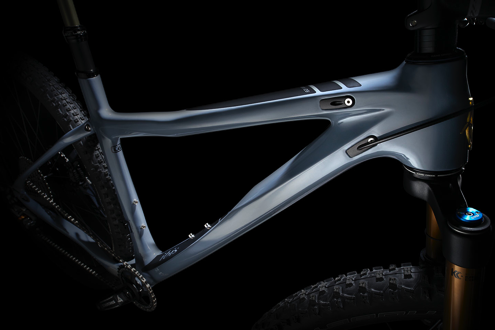
And this:
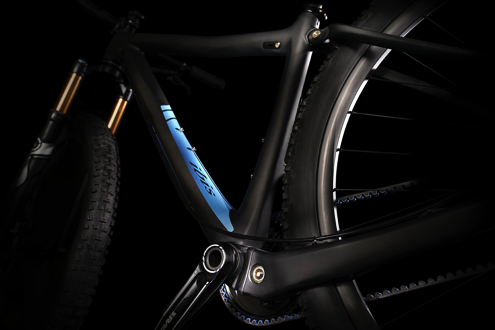
“MUST. HAVE. NOW,” I texted him.
“It’s on its way to the US right now,” he told me. “Then some quality control checks. Then you can have one.”
“It’s called the Tranny 29?”
“Yep.”
I confessed to being slightly disappointed by this. I had lobbied to have the bike named “Clyde,” my middle name (and also one of the Pac Man ghosts).
But this is a minor thing. A thing I can live with. And also, I can have decals made for mine.
Meet My (Your) New Bike
Over the weekend, Chuck told me they were going to be announcing the Tranny 29 today. Like, now. And that this is what it looks like set up as a single:
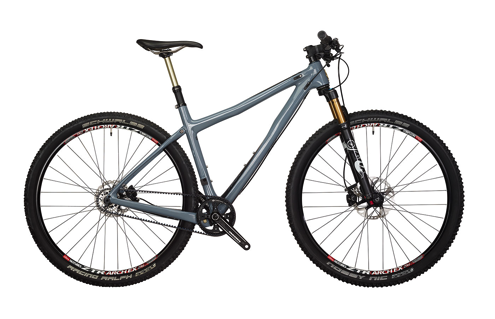
Or geared:
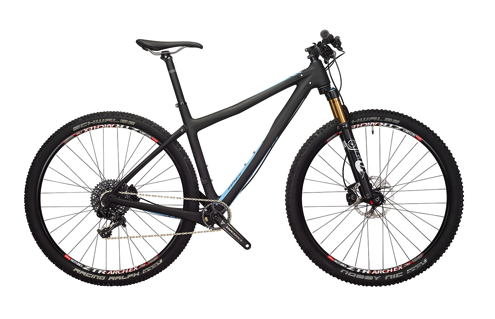
Chuck also pointed out that Jefe Branham had actually — the day before the planned Tranny 29 release — just won the Tour Divide on a Tranny 29. And that they had made a video just before Jefe had started the race. Here:
The Part That Excites Me
The Tranny 29 is a good-looking bike. And it’s an Ibis, so you know for sure it’s going to ride beautifully.
Those are things to be excited about, sure.
But it’s the rear triangle that makes all the difference to me. Its clever design makes it so you can break down and transport the bike a lot more easily than most mountain bikes.
And (for me, more importantly) it also solves a problem most singlespeeders have — or have had — for pretty much ever: chain tension.
See, when you don’t have a rear derailleur to tension your bike chain, you’ve got to do it some other way. For other bikes, this happens either at the bottom bracket, or at the dropout.
If you go with the dropout method, it means moving the rear wheel back to give it tension, which means adjusting the brakes and centering the wheel…and, at some point, probably having your wheel slip in the dropout.
Or if your bike has an eccentric bottom bracket, it means rotating the bottom bracket shell to give the chain tension. And I have never ever seen a bike using this method that doesn’t start creaking horribly at some point.
So I’m excited about the Ibis solution. You see that bolt down there by the crank?
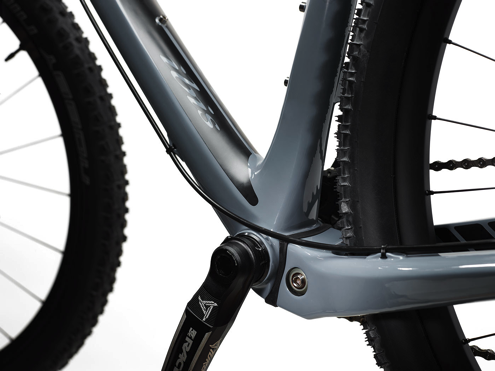
That’s called the “slot machine.” You loosen that bolt and one more at the top of the seat stay, lengthen the chainstay to tension the chain, and tighten it down. Easy.
Meanwhile, the wheel, its centered-ness and its position relative to the brake calipers remain rock-solid and unchanged, thanks to the 142mm Maxle rear axle.
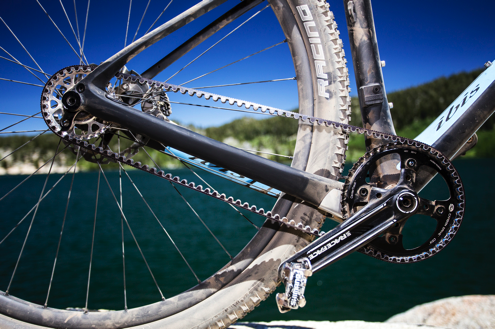
My Plans Have Changed
Would it surprise you to know that I have a Tranny 29 on order? No? Oh, you know me so well.
And would it surprise you to know that I have a SRAM XX1 drivetrain on order, too? Which means I’ll be able to change this bike from a geared to a singlespeed ridiculously easily? Like, almost on a whim?
No?
Well, would it surprise you to know that I also have a Gates Carbon Belt Drive setup on order, too, since—by virtue of the ability to remove the rear triangle—this bike is beltable?
OK, I bet that was a little bit of a surprise.
And how about this: I’m changing my Leadville Trail 100 registration. Where I was going to go geared this year, I think it’s time—based of course on whether I love this bike as much as Chuck thinks I will—for me to singlespeed this course on the bike I’ve been wishing for for about two years.
Excited? Yeah, I guess you could say I’m excited.
PS: Count on a real-time as-it’s-built post in the near future.
Comments (28)
06.27.2014 | 10:51 am
Here’s something I’m surprised to be finding out about myself: I like reviewing stuff, as long as it’s really interesting. Like, if I really love something and find myself thinking about why I’m drawn to it. Or if I really hate something and wonder how it ever came to see the light of day. Or if I’m just confused by something and wonder what I’m missing — or if perhaps the creator of that something just didn’t think things through.
For things like bikes and helmets and power meters, I may not be (ha!) qualified to do good reviews. Hey, I don’t even really work on my own bikes.
But for things like books, well, I do write. And I read a lot. And I like stories about people who ride bikes.
So you might be seeing more reviews here. And I’m going to be honest. Which may come across as a little tough sometimes. But I’m also going to be fair, and try to maintain my core philosophy (be kind).

Read — And Then Meet — Phil Gaimon (Garmin-Sharp)
This Monday, I’m going to be reviewing Phil Gaimon’s Pro Cycling on $10 a Day: From Fat Kid to Euro Pro.
And then, Tuesday — 12:00noon EDT / 11:00AM CDT / 10:00AM MDT / 9:00AM PDT — we’re going to have a live video chat with Phil on Spreecast. I have a bunch of questions for him, but would like you to use the comments question today to start asking your own.
Plus, be sure to attend the Spreecast; I’ll be sure to let as many of you as possible ask Phil your questions yourself.
I want to point out that — as I did with my review of Hincapie / Hummer’s book — I extended the opportunity to Gaimon to have a chance to respond to my review and answer questions, but have not shown him the review itself.
Unlike with the Hincapie / Hummer books, Gaimon accepted, in spite of the fact that he doesn’t know what will be in the review, nor its tone. So kudos to him for that.
Check back Monday for the review and info on watching / participating in the Spreecast.
Have a good weekend and ride lots.
Comments (15)
06.26.2014 | 1:40 pm
A Note from Fatty: This is part 7 of my 2014 Rockwell Relay report. If you need to catch up, you can go to the previous installment, or all the way to the beginning.
When you’re racing the Rockwell Relay, time becomes very, very strange. Weird even.
At one moment it’s early morning and you’re nervously awaiting the start of the race. Then the first teammate is racing and you’re cheering him on. Then — very quickly — your second teammate is out and you’re cheering her on. Then it’s your turn and you’re going with all your might. Then your fourth teammate is off and racing and you’re cheering her on.
And then it’s time to start that rotation again.
By the time this happens, you have two completely contradictory impressions. First, that you’ve been doing this race for all your life — that it’s just one endless cycle.
Secondly — and for me, this is the stronger impression — it’s that you’ve only been out racing for a very short time. That it’s still morning. Hey, you’ve each only gone on one middling-length ride after all, and you each got your respective rides out of the way pretty darn quickly.
So how was it possible that the sun was going down as Kenny was riding his second time?
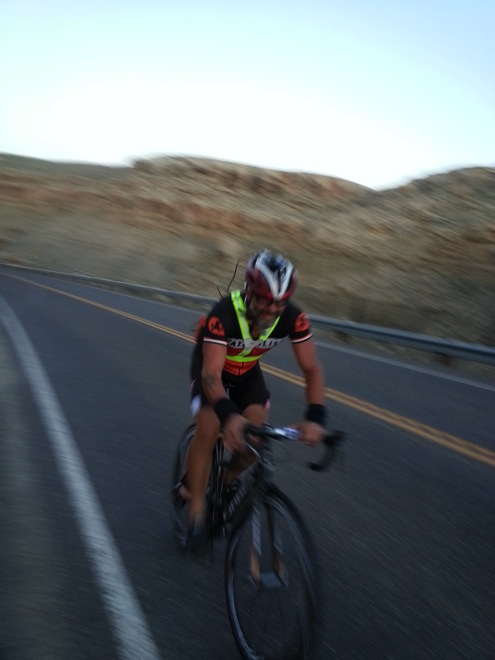
And why — why? — did the wind have to kick back up, pushing hard against Kenny for the whole ride?
These are mysteries we will likely never answer.
What we do know is that while Kenny rode, a beautiful full moon came up, so that it was never really completely dark.

So, as Kenny rode his leg and we found it impossible to get photos of him, we turned on each other:
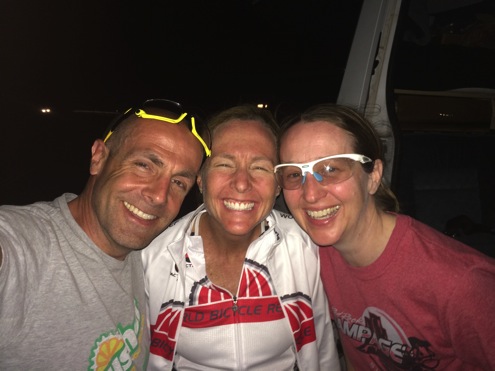
And then I got a shot of The Hammer and Heather, doing…some kind of dance or something. But the photo turned out different than I expected.
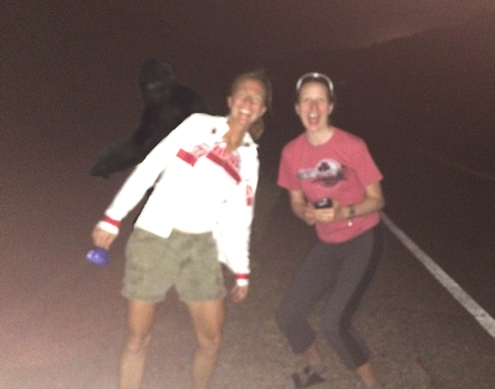
Wow, I think that was the chupacabra behind them. It’ too bad that’s such a dark, grainy, blurry shot.
Surreal
Once you’re riding in the dark, time gets even more strange and distorted during the Rockwell Relay. I think this is because there just aren’t the visual cues you’re used to during the day time to help you get a sense of time passing.
It’s just dark. And you feel a little bit weird, a little bit uneasy, getting ready for your ride.
Photos get really difficult to take:
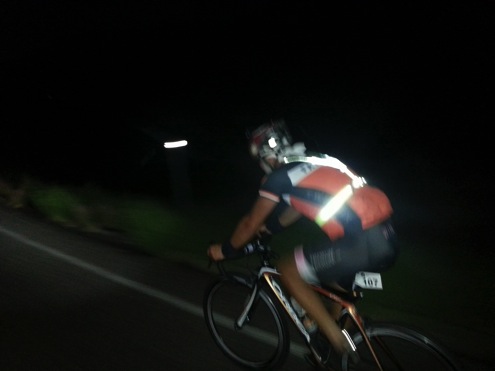
The only way I know that’s Kenny is because I recognize the Orbea.
We’d stare off into the dark, waiting to see a headlamp. Then we’d cheer for Kenny — at least we assumed it was Kenny — as we saw the light go by. And then we’d repeat.
When we got to within ten miles of the exchange, we left him, feeling just a little bit reluctant. It’s not easy to leave a teammate riding in the eerie darkness like that.
The Hammer’s Turn
Since I had already done the work of getting The Hammer’s bike ready, it was easy to get her ready:

Wow, those reflective belts really…reflect.
Then we stood around, waiting. Hoping that every light was Kenny’s. And soon enough, one was.
Kenny pulled in, having — as Kenny does — completely demolished himself on the ride. Kenny always gives it everything he’s got. That’s why he’s Kenny.
In endurance running relay races (like Ragnar), someone you pass is known as “roadkill.”
The Hammer was heading out with a monster climb in front of her.
Soon, that climb would be brimming with roadkill.
Which is where we’ll pick up next in the next installment of this story.
Comments (18)
06.25.2014 | 11:23 am
A Note from Fatty: This is part 6 in an ongoing series recounting my 2014 Rockwell Relay experience. If you’re new here, you might want to jump to the beginning. Or if you just need to catch up, this installment picks up where part 4 leaves off. The video of the event is part 5, but isn’t really part of the narrative.
We were worried about Heather. We had worried about her for weeks. Maybe months. And we had a good reason to be worried.
Heather was starting up what had been, last year, an utterly horrible leg of the race. Last year it had begun with an exploding tire, a mis-shifting derailleur, impossibly brutal heat, and a headwind that no person should have to battle alone…but which Heather had had to battle. Alone.
And we had watched her suffer.
That leg of the race has left deep psychological scars on every single member of Team Fatty. Deep scars on Heather; maybe deeper on those of us who had to watch.
And so we had prepared.
Kenny, Lisa and I had a plan where, if and when the headwind became intolerable, one of us would suit up and ride with Heather, taking turns pulling. This was an explicitly legal tactic in the race; we had looked it up and highlighted it in the race bible.
Heather, meanwhile, had been training specifically for this leg of the race. She had been seeking out opportunities to ride in the heat. To ride in the wind.
Imagine that: seeking those things out. So that she could kick butt on behalf of our team.
Heather is awesome.
And it was time to see how our preparations — our strategies — were going to play out.
Vanquished
I rolled in and Heather rolled out, then — after Kenny loaded my bike and I drank about a half gallon of cold water — we climbed into the Sprinter van and gave pursuit.
“What’s the temperature?” The Hammer asked Kenny.
“Not quite ninety yet.” Which still sounds pretty hot…until you consider this is about ten degrees cooler than it had been last year.
We caught up with Heather, worried that she would look like this:
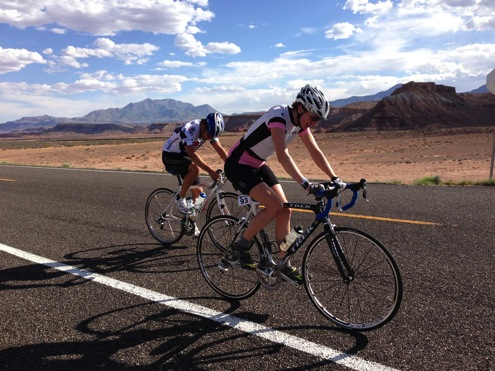
Heather, head bowed, staring at her stem and battling the wind and heat.
Instead, she looked like this:
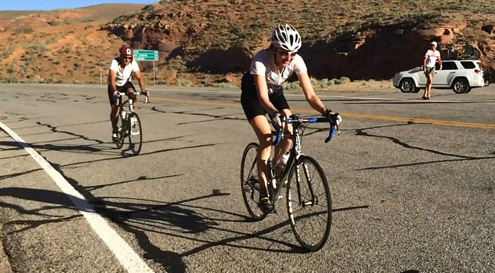
We didn’t even have to ask how she felt or how she was riding. The fact is, Heather looked and was riding great. It was that obvious. The big smile plus the guy she just dropped during the climb told that story pretty well.
Our mood shifted from anxious to excited and hopeful: just like that.
Heather was strong and feeling good! The heat was bearable! And the wind was at her back! And now I’m using a lot of exclamation points! I can’t help myself!
Deep breath, Fatty.
The point is, Heather was crushing this usually-demoralizing leg, in spite of the fact that there was nobody she could ride with.
The Secret of Our Success
In person, in email, in text messages and in comments, a lot of people have noted to me how much fun Team Fatty seems to be having in my video of this race. How it looks like it’s just a big adventure.
Well, let me let you in on a little secret: That’s actually how the race is for us. Sure, we like this race because of the route and the interesting format and the competition, but — more than anything else — we like this race because it’s a fun weekend with friends.
So let me make a recommendation to future Rockwell Relay attendees: if what you care about is winning or placing or whatever, find the fastest people you can for your team. But if what you care about is having an amazing weekend that you’ll never forget, make sure you build a team of friends.
Because that is what makes Team Fatty great.
Which leads in a tangential way to the way our team supports itself. We don’t use a “crew;” we crew for each other. Taking care of each other is part of the experience. It makes the race less about you and more about the team. And that’s a fantastic thing.
And extending from that philosophy is how much support our team gives each other. Which is to say, our team is never more than a couple miles away from our racer. We pull in front, pile out of the van (more enthusiastically during the day, less enthusiastically at night), and cheer our racer on.
Here’s Kenny (The Hammer’s right behind him, but you can’t see her in this shot), ringing the cowbell and hollering for Heather. Out in the middle of nowhere.
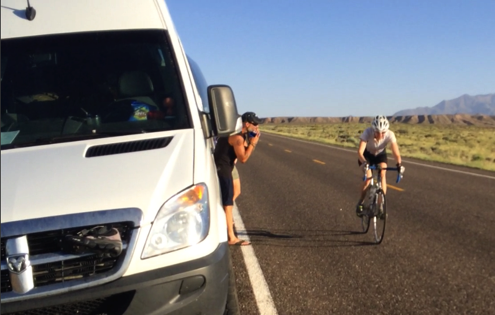
And here’s Heather about one second later:
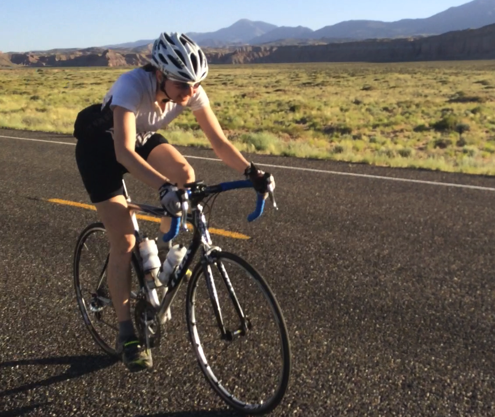
Big smile on her face. Riding with intensity. Having a great ride, in spite of the fact that it’s a barely-there uphill that goes on forever, as if it’s designed to make you think it’s flat while still slowing you down.
I tell you, having your team there — and making some noise for you — makes a huge difference in how hard you ride and how much you’re willing to give. Huge.
Plus, when you’re supporting each other, you get chances to master one of the most subtle and complicated cycling moves there is: the bottle handoff. Here’s the windup, where The Hammer starts running backward, matching speed.
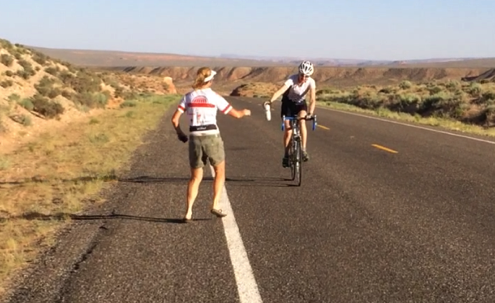
And the connection is made…
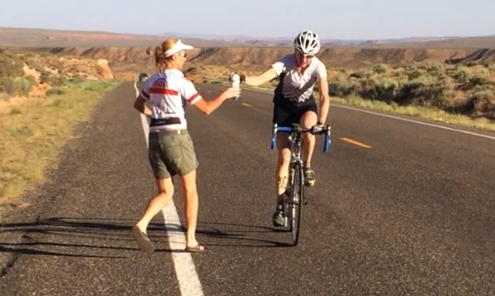
Annnnnd…success! The Hammer swings the bottle wide and out of the way:
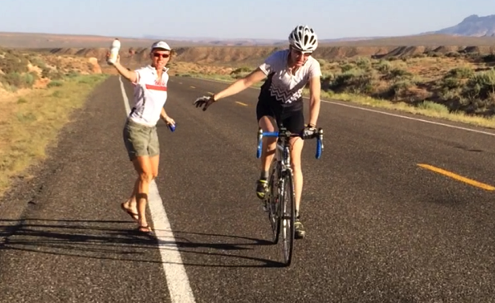
A perfect handoff. Full marks, and ten bonus points for style to each participant.
Yes, Please Tell Me How Much I Suck
Heather passed racer after racer, and was passed by not a single racer herself. What a difference a few degrees and a tailwind makes!
So when she had ten miles to go, we left her and headed out to the next exchange point, where Kenny could get himself ready. Time seemed to go so fast during this race that it felt surprising that Kenny’d be riding through the sunset and into the dark. But that’s how it would be, and he got geared up in his reflective belt and headlamp — a blinky light in back.
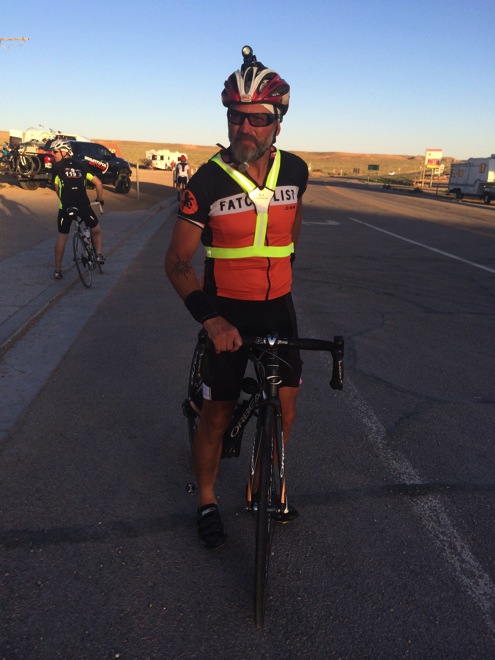
All he needed to do now was wait for Heather.
I, meanwhile, was in the busiest transition of the day. The Hammer was up next, and she’d be riding in the full dark, with a significant descent. And then after her, I’d be riding in the dark with a big descent. And once it got dark, it would be a lot more difficult to get lights mounted on her bike, my bike, her helmet, and my helmet.
Also, the next two exchanges happen quickly; I wouldn’t have a lot of time to get the riders (The Hammer next, myself the time after that) as well as the bikes ready.
So this was my opportunity on getting bikes prepped for night riding, and I was pretty focused. And probably a little terse. And quite likely a little surly.
Which, somehow, made several people want to come and talk to me. And, apparently, they thought that this was a good opportunity to tell me how much faster they were than I was during our first leg. Or, in one case, how he could have been faster than me…but wasn’t really giving it his all.
Later, as I was telling The Hammer how much it bothered me that people would seek me out specifically to tell me they beat my time (or would have if they had been trying), she explained that it was really a compliment — that these people were using me as a yardstick of their own speed.
“Yeah, I get that — I do the same thing,” I said. I’ve used Kenny as my personal yardstick of speed for…well…pretty much ever. “But they don’t need to come seek me out to tell me they’re better than me.”
“You’re too sensitive,” The Hammer replied.
It’s true. I am. I’m not proud of it, but I’m extremely sensitive. Kind of a baby, really.
And I’m also the kind of person who looks for revenge.
That opportunity would come. Soon.
Real soon.
PS: To read the next installment in this series, click here.
Comments (25)
« Previous Entries Next Page »
 Review: Pro Cycling on $10 a Day, by Phil Gaimon
Review: Pro Cycling on $10 a Day, by Phil Gaimon



















